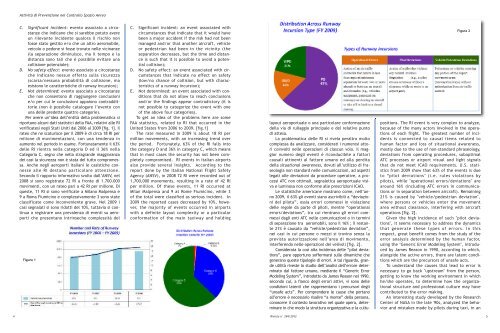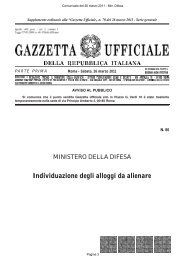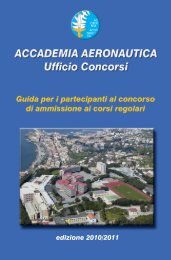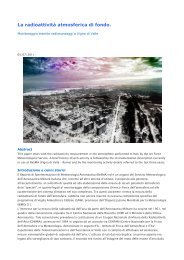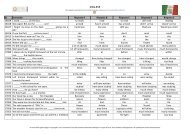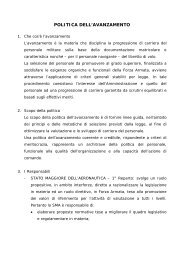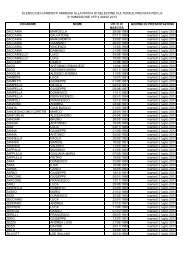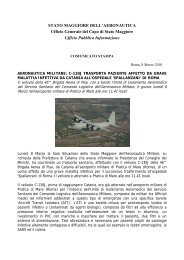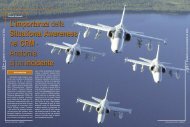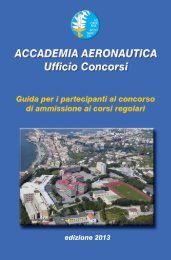Scarica l'intera rivista in formato pdf - Aeronautica Militare Italiana
Scarica l'intera rivista in formato pdf - Aeronautica Militare Italiana
Scarica l'intera rivista in formato pdf - Aeronautica Militare Italiana
Create successful ePaper yourself
Turn your PDF publications into a flip-book with our unique Google optimized e-Paper software.
Attività di Prevenzione nel Controllo Spazio Aereo<br />
C. Significant <strong>in</strong>cident: evento associato a circostanze<br />
che <strong>in</strong>dicano che si sarebbe potuto avere<br />
un rilevante <strong>in</strong>cidente qualora il rischio non<br />
fosse stato gestito e/o che un altro aeromobile,<br />
veicolo o pedone si fosse trovato nelle vic<strong>in</strong>anze<br />
(la separazione dim<strong>in</strong>uisce, ma il tempo e la<br />
distanza sono tali che è possibile evitare una<br />
collisione potenziale);<br />
D. No safety effect: evento associato a circostanze<br />
che <strong>in</strong>dicano nessun effetto sulla sicurezza<br />
(scarsa/nessuna probabilità di collisione, ma<br />
esistono le caratteristiche di runway <strong>in</strong>cursion);<br />
E. Not determ<strong>in</strong>ed: evento associato a circostanze<br />
che non consentono di raggiungere conclusioni<br />
e/o per cui le conclusioni appaiono contraddittorie<br />
(non è possibile catalogare l’evento con<br />
una delle predette quattro categorie).<br />
Per avere un’idea dell’entità della problematica si<br />
riportano alcuni dati statistici della FAA, relativi alle RI<br />
verificatesi negli Stati Uniti dal 2006 al 2009 [fig. 1]. Il<br />
rateo che ne scaturisce per il 2009 è di circa 18 RI per<br />
milione di movimentazioni, con una tendenza <strong>in</strong><br />
aumento nel periodo <strong>in</strong> esame. Fortunatamente il 63%<br />
delle RI rientra nella categoria D ed il 36% nella<br />
Categoria C, segno che nella stragrande maggioranza<br />
dei casi la sicurezza non è stata del tutto compromessa.<br />
Anche negli aeroporti italiani le casistiche connesse<br />
alle RI destano particolare attenzione.<br />
Secondo il rapporto <strong>in</strong>formativo svolto dall’ANSV, nel<br />
2008 si sono registrate 72 RI a fronte di 1.700.000<br />
movimenti, con un rateo pari a 42 RI per milione. Di<br />
queste, 11 RI si sono verificate a Milano Malpensa e<br />
9 a Roma Fiumic<strong>in</strong>o e complessivamente 3 sono state<br />
classificate come <strong>in</strong>conveniente grave. Nel 2009 i<br />
casi segnalati si sono ridotti del 10%, tuttavia si cont<strong>in</strong>ua<br />
a registrare una prevalenza di eventi su aeroporti<br />
che presentano <strong>in</strong>tr<strong>in</strong>seche complessità del<br />
Figura 1<br />
C. Significant <strong>in</strong>cident: an event associated with<br />
circumstances that <strong>in</strong>dicate that it would have<br />
been a major accident if the risk had not been<br />
managed and/or that another aircraft, vehicle<br />
or pedestrian had been <strong>in</strong> the vic<strong>in</strong>ity (the<br />
separation decreases, but the time and distance<br />
is such that it is possible to avoid a potential<br />
collision);<br />
D. No safety effect: an event associated with circumstances<br />
that <strong>in</strong>dicate no effect on safety<br />
(low/no chance of collision, but with characteristics<br />
of a runway <strong>in</strong>cursion);<br />
E. Not determ<strong>in</strong>ed: an event associated with conditions<br />
that do not allow to reach conclusions<br />
and/or the f<strong>in</strong>d<strong>in</strong>gs appear contradictory (it is<br />
not possible to categorize the event with one<br />
of the above four categories).<br />
To get an idea of the problems here are some<br />
FAA statistics, related to RI that occurred <strong>in</strong> the<br />
United States from 2006 to 2009. [fig.1]<br />
The rate measured <strong>in</strong> 2009 is about 18 RI per<br />
million movements, with an <strong>in</strong>creas<strong>in</strong>g trend over<br />
the period. Fortunately, 63% of the RI falls <strong>in</strong>to<br />
the category D and 36% <strong>in</strong> category C, which means<br />
that <strong>in</strong> most cases the security has not been completely<br />
compromised. RI events <strong>in</strong> Italian airports<br />
also provide several <strong>in</strong>sights. Accord<strong>in</strong>g to the<br />
report done by the Italian National Flight Safety<br />
Agency (ANSV), <strong>in</strong> 2008 72 RI were recorded out of<br />
1,700,000 movements, result<strong>in</strong>g <strong>in</strong> a rate of 42 RI<br />
per million. Of these events, 11 RI occurred at<br />
Milan Malpensa and 9 at Rome Fiumic<strong>in</strong>o, while 3<br />
of the total were classified as serious <strong>in</strong>cident. In<br />
2009 the reported cases decreased by 10%, however,<br />
the majority of events occurred <strong>in</strong> airports<br />
with a def<strong>in</strong>ite layout complexity or a particular<br />
conformation of the ma<strong>in</strong> taxiway and hold<strong>in</strong>g<br />
layout aeroportuale o una particolare conformazione<br />
della via di rullaggio pr<strong>in</strong>cipale e del relativo punto<br />
di attesa.<br />
La problematica delle RI si rivela peraltro molto<br />
complessa da analizzare, considerati i numerosi attori<br />
co<strong>in</strong>volti nelle operazioni di ciascun volo. Il maggior<br />
numero degli eventi è riconducibile a fattori<br />
causali att<strong>in</strong>enti al fattore umano ed alla perdita<br />
della situational awareness, dovuti all’utilizzo di fraseologia<br />
non standard nelle comunicazioni, ad aspetti<br />
legati alle deviazioni da procedure operative, a processi<br />
ATC non ottimali, segnaletica aeroportuale visiva<br />
e lum<strong>in</strong>osa non conforme alle prescrizioni ICAO.<br />
Le statistiche americane mostrano come, nell’anno<br />
2009, il 63% gli eventi siano ascrivibili a “deviazioni<br />
del pilota”, ossia errori commessi <strong>in</strong> violazione<br />
delle regole da parte di piloti, mentre “operational<br />
errors/deviations”, tra cui rientrano gli errori commessi<br />
dagli enti ATC nelle comunicazioni o <strong>in</strong> term<strong>in</strong>i<br />
di separazione tra aeromobili, sono il 16% ; il restante<br />
21% è causato da “vehicle/pedestrian deviation”,<br />
nei casi <strong>in</strong> cui persone o mezzi si trov<strong>in</strong>o senza la<br />
prevista autorizzazione nell’area di movimento,<br />
<strong>in</strong>terferendo nelle operazioni dei velivoli [fig. 2].<br />
Considerata la così alta <strong>in</strong>cidenza delle “pilot deviations”,<br />
pare opportuno soffermarsi sulle d<strong>in</strong>amiche che<br />
generano queste tipologie di errori. A tal riguardo, grande<br />
utilità riveste lo studio dell’analisi dell’errore determ<strong>in</strong>ato<br />
dal fattore umano, mediante il “Generic Error<br />
Model<strong>in</strong>g System”, <strong>in</strong>trodotto da James Reason nel 1990,<br />
secondo cui, a fianco degli errori attivi, vi sono delle<br />
condizioni latenti che rappresentano i precursori degli<br />
“unsafe acts”. Per comprendere le cause che portano<br />
all’errore è necessario risalire “a monte” della persona,<br />
conoscere il contesto lavorativo nel quale opera, determ<strong>in</strong>are<br />
<strong>in</strong> che modo la struttura organizzativa e la cultu-<br />
Figura 2<br />
positions. The RI event is very complex to analyze,<br />
because of the many actors <strong>in</strong>volved <strong>in</strong> the operations<br />
of each flight. The greatest number of <strong>in</strong>cidents<br />
is connected to causal items related to<br />
human factor and loss of situational awareness,<br />
mostly due to the use of non-standard phraseology,<br />
deviations from operat<strong>in</strong>g procedures, suboptimal<br />
ATC processes or airport visual and light signals<br />
that do not meet ICAO requirements. U.S. statistics<br />
from 2009 show that 63% of the events is due<br />
to “pilot deviations" (i.e. rules violations by<br />
pilots), while "operational errors/deviations" are<br />
around 16% (<strong>in</strong>clud<strong>in</strong>g ATC errors <strong>in</strong> communications<br />
or <strong>in</strong> separation between aircraft). Rema<strong>in</strong><strong>in</strong>g<br />
21% is caused by "vehicle/pedestrian deviation",<br />
where persons or vehicles enter the movement<br />
area without clearance, <strong>in</strong>terfer<strong>in</strong>g with aircraft<br />
operations [fig. 2].<br />
Given the high <strong>in</strong>cidence of such "pilot deviations",<br />
it seems necessary to address the dynamics<br />
that generate these types of errors. In this<br />
respect, great benefit comes from the study of the<br />
error analysis determ<strong>in</strong>ed by the human factor,<br />
us<strong>in</strong>g the "Generic Error Model<strong>in</strong>g System", <strong>in</strong>troduced<br />
by James Reason <strong>in</strong> 1990, accord<strong>in</strong>g to which,<br />
alongside the active errors, there are latent conditions<br />
which are the precursors of unsafe acts.<br />
To understand the causes that lead to error is<br />
necessary to go back "upstream" from the person,<br />
gett<strong>in</strong>g to know the work<strong>in</strong>g environment <strong>in</strong> which<br />
he/she operates, to determ<strong>in</strong>e how the organizational<br />
structure and professional culture may have<br />
contributed to the error mak<strong>in</strong>g.<br />
An <strong>in</strong>terest<strong>in</strong>g study developed by the Research<br />
Center of NASA <strong>in</strong> the late '90s, analyzed the behavior<br />
and mistakes made by pilots dur<strong>in</strong>g taxi, <strong>in</strong> an<br />
4<br />
Rivista n° 294/2012<br />
5


